Transcription of WEB Knife SharpeningDocument - Buck Knives
1 Knife Sharpening Every Knife needs sharpening from time to time. With the following instructions, you will be using the safest and most effective method of sharpening your Knife . If you are looking for other information about Knife care, please refer to , Knife Care & Repair or Warranty. What not to do Never sharpen your Knife on a power-driven grinding wheel. This can burn the temper from your blade, which will make the edge brittle and possibly chip or crack. Sharpening your Knife in this manner will void the warranty. Knife Sharpening Equipment For best results, use a sharpening stone.
2 For quick touch-ups on a blade that is not too dull, use our fine grit diamond sharpening stone or our Arkansas Washita honing stone. For a more thorough sharpening on a blade that is dull, use the coarse grit stone first, then go to the fine grit stone or stones. Diamond sharpening stones may be used dry or wet, but wet is recommended. When using them wet, use water, not oil, as a lubricant. Natural Washita stones should be used wet. You may choose to use your stand-alone Washita stone (not attached to the Tri-Stone system) with honing oil as a lubricant.
3 Once you do this, water will no longer work well as a lubricant and you will need to use kerosene or honing oil to keep your stone clean. After each use, dry your sharpening stone. For information on sharpeners, please see , Accessories. a. Types of Sharpeners Diamond Stone Sharpeners A metal or composite base with an outer layer of micron-sized diamonds bonded to a metal surface. Many diamond sharpeners have special surface holes to prevent filing build-up. Fast-acting and very effective. Use care to avoid excess pressure. Natural Stone Sharpeners Arkansas natural stones are genuine silica Novaculite , indigenous to Arkansas.
4 They come in different grits and have abrasive properties well suited for Knife sharpening. b. Types of sharpening fluid Some people recommend sharpening dry and cleaning the sharpener as needed. Our recommendation is to sharpen wet because it keeps the pores of the sharpener clean, dissipates frictional heat and facilitates smooth sharpening action. Diamond Sharpeners: Can be used wet or dry. If using a diamond sharpener wet, use water or water-based honing oil, not petroleum based oil. Natural Sharpening Stones: Can be used wet or dry. Water, water-based honing oil or petroleum-based honing oil can be used.
5 Be generous with the honing fluid. Use enough to keep a pool visible on the stone while you are sharpening. When the pool gets murky, pat or lightly wipe up with a rag and add more fluid. Note: Once you use oil on a natural or aluminum oxide stone, it is difficult to change back to using water. Treat the decision to use oil as a permanent one. c. Handle a sharpener with care to protect its surface Do not drop. Protect the surface during use and storage. After every use, use a little extra fluid and wipe the sharpener clean and dry. Clean sharpening stone periodically to eliminate debris build-up (swarf).
6 Glossy grey streaks indicate debris build-up. - If you sharpen with water or water-based honing oil, clean sharpening stone with soapy water. - If you sharpen with petroleum-based honing oil, clean sharpening stone with kerosene or more honing oil. - Scrub with your finger or a mild brush, such as a used toothbrush. d. Practice sharpening on a non-valuable Knife Through the process of sharpening, scratches may occur beyond the edge of the blade. If you are new to sharpening, you may wish to practice on an old or inexpensive Knife first to get the feel for avoiding unwanted scratches.
7 Sharpening Instructions Straight blades Serrated blades Gut hooks Fish hooks and small, pointed objects Small tools Sharpening straight blades (non-serrated) - Inspect your blade condition by holding the Knife , edge up, and looking down the length of the blade Look for nicks or flats spots reflected by light. - Is the blade nicked or extremely dull? Start with Stage 1, Coarse Grit Stone. - Is the blade somewhat dull or just needs a touch-up? Start with Stage 2 or Stage 3. STAGE 1: HEAVY SHARPENING COARSE GRIT SHARPENER - For extremely dull blades, inconsistent edge, or nicks/dull spots.
8 This stage is the rough cut to remove inconsistencies in the blade edge and take it from very dull to sharp, but not finished. buck s Diamond Sharpening Stone, Model 1327, has coarse 325 grit, suitable for stage 1 sharpening. a. Sharpening fluid. - Diamond Sharpeners: Can be used dry or wet. If lubrication is desired, use water or water-based honing oil, not petroleum based oil. - Natural Sharpening Stones: Can be used dry or wet. Water, water-based honing oil or petroleum-based honing oil can be used (see Knife Sharpening Notes for recommendations).
9 B. Hold the correct grind angle. Ideally, follow the grind and edge angle as they were when new. Scratches on the blade happen when sharpening. Use them to measure if you re angled too high or too flat against the stone, or if you re skipping off the edge of the stone. The angle on a buck Knife is ground to 13-16 degrees per side (see illustrations). If you hold the Knife against the stone to cut evenly across the edge grind, you will produce an edge with a similar angle. If you hold the blade at too high of an angle, the resulting edge will lose some slicing ability (but will stand up better to chopping).
10 A good rule of thumb is to hold the blade so the back of it is about one blade width up from flat on the stone. c. Stroke the blade across the sharpener with even control. Too much pressure will crush or remove the grit from a diamond sharpener. It will also force a thicker burr on the edge, which is harder to remove or which can break off, creating new flat spots on the edge. Your stroke can be straight or circular, from hilt to tip or- tip to hilt, whichever is more comfortable. With most portable sharpeners, you need to stroke in a straight direction.






